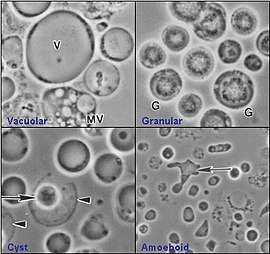
Blastocystis

Blastocystis is a genus of single-celled heterokont parasites belonging to a group of organisms that are known as the Stramenopiles (also called Heterokonts) that includes algae, diatoms, and water molds. Blastocystis consists of several species, living in the gastrointestinal tracts of species as diverse as humans, farm animals, birds, rodents, reptiles, amphibians, fish, and cockroaches. Blastocystis exhibits low host specificity, and many different species of Blastocystis can infect humans and by current convention, any of these species would be identified as Blastocystis hominis. Blastocystis is one of the most common human parasites in the world and has a global distribution. It is the most common parasitic infection in the United States, where it infected approximately 23% of the total population during year 2000. In less developed areas, infection rates as high as 100% have been observed. High rates of infection are found in individuals in developed countries who work with animals. Although the role of Blastocystis hominis in human disease is often referred to as controversial, a systematic survey of research studies conducted by 11 infectious disease specialists from nine countries, found that over 95% of papers published in the 10 years prior identified it as causing illness in immunocompetent individuals. The paper attributed confusion over pathogenicity to the existence of asymptomatic carriers, a phenomenon the study noted is common to all gastrointestinal protozoa. However, Blastocystis has never fulfilled Koch's postulate that infection of a healthy individual with Blastocystis leads to disease. The fact that Blastocystis' infection route is oral-anal indicates that carriers have been in contact with faecal contaminated matter which might have included other intestinal pathogens that explain the observed symptoms. A more likely explanation is the presence of virulent and non-virulent strains as there exists and enormous genetic variation between different strains (or genotypes). See the genotype paper by Rune Stensvold and the recent Blastocystis genome paper expanding on this diversity. An alternative theory that Blastocystis is not a pathogen at all has recently been strengthened based on its biochemistry. The appropriate classification of Blastocystis has only recently been resolved. The original description of Blastocystis was as a yeast due to its yeast-like glistening appearance in fresh wet mounts and the absence of pseudopodia and locomotion. This was then contradicted by Zierdt, who reclassified it under subphylum Sporozoa (and later in Sarcodina), based on some distinctive protistan features of the Blastocystis cell. Its sensitivity to antiprotozoal drugs and its inability to grow on fungal media further indicated that it was a protozoan. However, major revisions were made to its classification. An analysis of gene sequences was performed in 1996, which placed it into the group Stramenopiles.Other Stramenopiles include brown algae, mildew, diatoms, the organism that caused the Irish potato famine, and the organism responsible for Sudden oak death disease. However, the position of Blastocystis within the stramenopiles remains enigmatic. Most published studies have reported that between 50% and 80% of individuals mono-infected with Blastocystis will show symptoms. Factors influencing presentation of symptoms have been listed as the patient's age, with younger patients less likely to show symptoms, as well as genetic changes that influence the production of cytokines. Some studies have suggested that pathogenicity may be linked to specific subtypes of Blastocystis and experimental infection of animals has reported varying degrees of illness depending on the subtype used. While some subtypes appear to be less likely to result in symptomatic infection, those subtypes are also found in symptomatic individuals who have no other infection found. Symptoms associated with the infection are diarrhea, constipation, nausea, abdominal cramps, bloating, excessive gas, and anal itching. Most cases of the infection appear to become diagnosed as irritable bowel syndrome, according to studies from Denmark, Pakistan, the United Kingdom, and Italy. The timescale of infection with the parasite can range from weeks to years. In the early 2000s, Egyptian physicians identified 84 patients with diarrhea and enteritis apparently caused by Blastocystis hominis. After three days of nitazoxanide treatment, symptoms cleared and no fecal organisms were detectable in 36 (86%) of 42 treated patients and in 16 (38%) of 42 people who received placebo (P < .0001). the investigators concluded that either B hominis is pathogenic and can often be effectively treated with nitazoxanide, or that nitazoxanide (a drug approved by the FDA for the treatment of giardia and cryptosporidia) eradicated an unidentifiable organism. For many years, scientists believed one species of Blastocystis infected humans, while different species of Blastocystis infected other animals. So they called Blastocystis from humans Blastocystis hominis and gave different species names to Blastocystis from other animals, for example Blastocystis ratti from rats. In recent years, various genetic analysis have shown that Blastocystis hominis as a unique entity does not exist, i.e. there is no single species of Blastocystis that infects humans. In fact, a number of distinct genetic types of Blastocystis can infect humans, including those previously called Blastocystis ratti and the differences are so great that they could be considered separate species. Because of this, in 2007 scientists proposed discontinuing the use of the term Blastocystis hominis. Their proposal was to refer to Blastocystis from humans and animals as Blastocystis sp. subtype nn where nn is a number assigned to each group according to the degree of genetic identity of the Blastocystis organisms, based on gene sequences, rather than the host that was infected. At that time nine subtypes were known to infect mammals and birds, all of which had been found in humans. A tenth group was reported in China in 2007, but a full analysis of its relationships has not yet been performed and it is not yet clear whether it is a group within a described subtype or a new subtype. A definite tenth subtype was then found in a variety of other mammals, including primates, but it has not as yet been found in humans.
